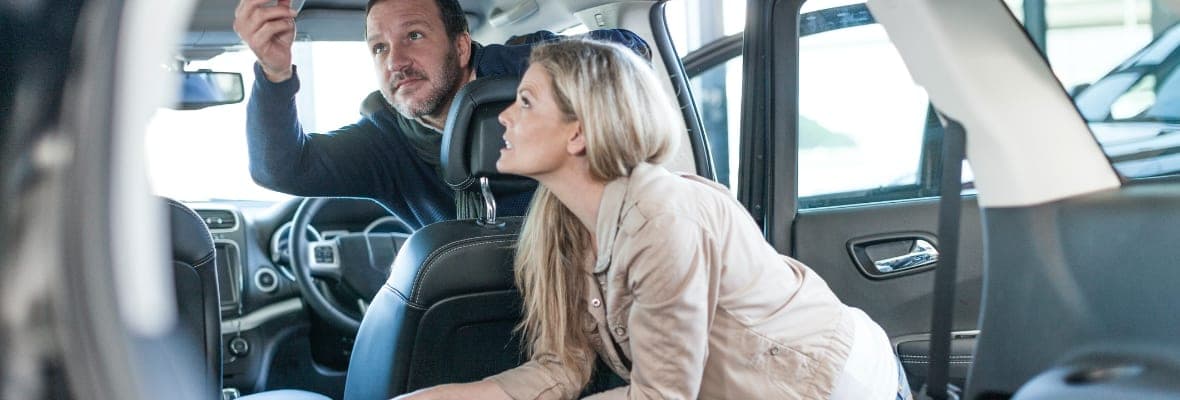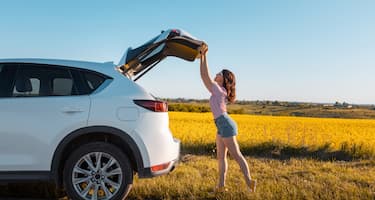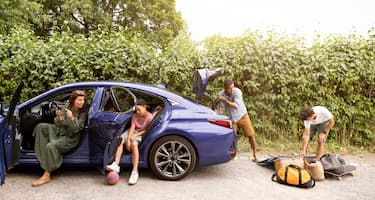Buying a second-hand car can be exciting, but if you end up spending thousands on a lemon it can also be quite stressful.
That's why you need to make sure you're not paying more than you need to, and also consider the cost of future maintenance, repairs, and parts replacement. Estimating these potential costs is important to help avoid unexpected financial burdens down the road.
So if you're about to start your used car journey, check out our guide on what to look out for before making your final decision.
What to Check When Buying a Used Car
Buying a new vehicle can be as easy as checking car safety ratings and making sure it looks good and feels good. Unfortunately, the same can't be said for buying a used car.
There's plenty to look at before you buy, so make sure you're ready for the journey by checking our list below.
Research Car Models
Some car models can be more affordable to service and repair, so be sure to look into different makes and models, the average cost to service them, and what suits your budget.
For example, there are some car manufacturers whose cars are known to be much more affordable and quicker to repair as their parts are easily sourced when the time comes for servicing.
Confirm the Owner
Before buying a used vehicle through a private sale, it's important to make sure the seller is also the owner of the car.
This is to avoid unknowingly buying a stolen car. Even though you won't be charged for buying a stolen vehicle, it's likely the car will be repossessed and returned to its owner or the insurance company.
You can confirm the owner of the car by going through Budget Direct's free Personal Property Securities Register (PPSR) search.
This will give you the description of the car and its registration plate which you can compare to the seller’s current registration papers to make sure it all matches up. It’s also important to verify the car’s registration details through official sources to ensure the vehicle is properly registered.
You can do this through using the car's registration number or Vehicle Identification Number (VIN) to run a free registration check on your state or territory's official transport department website.
The PPSR search will also show if there's any money owing on the car. If you buy a car that still has money owing on its loan and the previous owner stops paying, the lender can take your car.
If the vehicle identification number (VIN) has been tampered with, it's probably a bad sign. But in a pinch, you can also use the engine number to properly identify the car.
Interior Upkeep
Say you’ve got two used cars with the same make and model, the same kilometres on the odometer and the same colour paint.
They could still have different upfront costs, depending on how their owners looked after them. Trapped pet fur, stains and bad smells can all diminish the value of a car.
When looking at the interior, make sure you look at how the car feels, looks and smells. Additionally, check out the quality of interior accessories like mirrors, steering wheel and seat quality.
You can also check warning lights, seat belts, air conditioning, power windows, parking sensors, interior plastics and central locking.
It’s just important to recognise the difference in value with a used vehicle and make sure you're not overpaying.
Check for Accident Damage
No one wants to buy a used car and end up with egg on their face. First, you want to find out if the car has been in an accident and if so, how bad it was. Researching the car's history can help you make an informed decision before purchasing, such as uncovering past accidents that caused the vehicle to have been written off.
While it's hard to find out about every bump and scrape in the vehicle's history, a PPSR test will tell you if the car has ever been written off.
Some repairable write-offs are fixed, inspected and re-registered to be sold, but a lot of the time it's hard to know from face value if the repairs are up to standard.
To make sure you're not buying a dodgy vehicle, you can organise an independent vehicle inspection through a mechanic to find out what crash repairs it's had done and how well they were done.
Many accidents are minor and can be repaired easily, so don't rule out an accident car before you've had it checked.
At the very least, the seller should provide you with a valid roadworthy certificate to show it's been officially approved to drive on the road.
The car should be in good condition to ensure reliability and help you avoid costly repairs in the future.
Look Under the Bonnet
Before buying a used car, one of the most important places to look is under the bonnet. But a lot of the time it can be hard to know what you're looking at.
If there's any build-up of dirt and road grime in the engine, it can be a sign of fluid leaks.
These could be leaks in the power-steering pump, radiator, hoses, transmission, oil pan, engine seals or oil-cooler lines. Another obvious sign is if the fluids are leaking onto the ground underneath the car.
Radiator coolant leaks leave a light-coloured residue or stain, power-steering fluid has a reddish colour, while oil is dark and greasy.
Meanwhile, white smoke in a car's exhaust can be a sign that the coolant has drained into its combustion chamber which can be a serious problem.
Leaks and white smoke are usually signs of wear and tear often paired with poor maintenance.
And although you should expect a bit of wear and tear when buying a used car, too much could either warrant a price decrease or for you to walk away altogether.
Inspect the Panels and Paint
Ideally, a used car shouldn't have any dents, dings, rust, chips or oxidation when you inspect it. But sometimes it can be hard to tell if there's been any incidents in the past.
Some key things to look out for include:
- Inconsistently wide gaps between body panels, mostly between the bonnet and front bumper.
- Dimpled or blistered paint which usually means rust has spread from the inside of the panels from not being washed regularly enough.
- Doors that sag on their hinges instead of swinging freely, closing securely and forming a weatherproof seal.
Examine the Tyres
In Australia, tyres legally need to have a minimum tread of 1.5mm for the car to be deemed roadworthy.
Not only is it a bad sign from the seller if the tyres are below the minimum wear indicators, but it also means if you end up buying the car, you'll be up for more money when you have to buy a new set.
Uneven wear on the front tyres can be linked to misaligned wheels while uneven wear on the back tyres could be due to a bent or warped chassis.
Meanwhile, tread crowning, wear that is heavier around the edges of the tread surface, and tread cupping, wear that is heavier toward the centre of the tyre, can be caused by under-inflated and over-inflated tyres.
Test the Transmission
A car's transmission makes sure your tyres get the right amount of power at all times. If the transmission isn't working, your car isn't going anywhere.
You can usually see if the transmission is in trouble in a used car if there's leaking fluid with a reddish colour.
Very dirty fluid might also mean it hasn't been maintained well which can then make the car sluggish to drive.
In a manual, you should feel constant pressure on your foot when you press down on the clutch. If it feels soft or spongy, this could be a sign of damage or leaking fluid lines.
Gear changes should be smooth when driving. If shift changes are jerking when you take the used car for a test drive, this could be a sign of weakening transmission. Test driving is essential to assess the car's performance under different conditions, such as acceleration, braking, and cornering. During the test drive, thorough testing of the vehicle's responsiveness, handling, and braking performance helps ensure the car is reliable and suitable for your needs.
You can also test the clutch in a manual by sitting the car in neutral with the handbrake on and holding the clutch pedal down for a couple of seconds before releasing.
Do this two or three times and if you hear any squeals or whines when the clutch is engaged, you might want to look at the transmission a bit more closely.
Questions to Ask When Buying a Used Car
If you're looking to buy a used car, here are some questions to ask as a used car checklist, and before making the deal:
- Why are you selling? If you don't feel comfortable with the seller's answer, you can move on to the next option.
- How many owners has it had? Often, a car that's had one owner could be in a better condition than with many owners.
- Can I see the paperwork? This includes the service logbook to make sure it's been properly maintained, the registration certificate to see when it expires and to confirm the ownership and the vehicle history report for any major services.
- Is there anything wrong with the car? You might not get a straight answer, but it's always good to cover all bases and ask the question.
- Can I have the car inspected by a mechanic? If the answer is no, you might have to start looking elsewhere.
- Can I take the car for a test drive? Taking a test drive can show you if the engine runs smoothly. So if the seller isn't keen on letting you in the driver's seat then there might be bigger issues at play.
- What was the car used for? A used vehicle that gets its owner to and from work might be in better condition than a work car that's clocked up some serious kilometres.
How to Buy a Used Car
There's plenty to consider when you're looking into buying a used car. For potential car buyers, here's a quick rundown of what you can expect when getting into the nitty gritty.
Dealerships vs Private Sale
There are a few key things to consider when you’re buying from a dealer compared to private sellers:
- No nasty surprises – If the engine packs up on your way home, you usually won’t be the one to pay for it. Dealerships tend to offer a statutory used car warranty, whereas there’s typically no protection when buying used vehicles privately.
- Financing options - You can source your own loan if you wish, but usually you can also arrange financing through the dealer. And of course, you can usually trade in your old car – an option that isn’t available when buying a car privately.
- Higher prices - All this convenience and safety can come with a natural consequence – prices go up. You might not save money buying through a dealer over a private seller, so it’s up to you to decide if the security is worth it.
No matter who you’re buying a used car from though, it’s worth knowing how to negotiate effectively.
Statutory Warranty and Cooling Off Period
One of the biggest positives to buying used vehicles through a motor dealer over buying privately are the Fair Trading laws across Australia that help protect potential buyers from purchasing a dodgy car.
The dealer guarantee means some used cars come with a warranty and a cooling-off period to make sure there's a legal backup if anything goes wrong right off the bat.
The warranty period for used cars differs from state and territory based on the age of the car, the purchase price of the car and the odometer reading.
| Cooling off period | Warranty length (whichever comes first) | Cars included | |
|---|---|---|---|
1 business day |
3 months or 5,000 km |
<160,000 km and <10 years old |
|
1 business day |
3 months or 5,000 km |
<160,000 km and <10 years old |
|
3 business days |
3 months or 5,000 km |
<160,000 km and <10 years old |
|
None |
3 months or 5,000 km |
<150,000 km and <10 years old |
|
SA [9] |
2 business days |
2 months or 3,000 km |
$3001-$6000 |
Tas [10] |
None |
3 months or 3,000 km |
<120,000 km and <7 years old |
None |
3 months or 5,000 km |
<160,000 km and <10 years old |
Buying a Used Car Checklist
Make sure you've ticked off most of this list before deciding to buy a used car:
- Do a PPSR check using the VIN or chassis number
- Take the car for a test drive
- Check the interior and exterior
- Get an independent mechanical inspection (especially important to consider for private sales)
- Check the paperwork including the service history, roadworthy certificate and registration expiry
- Check for warranty
- Ask the seller questions
- Negotiate the price
Key Takeaways
Private or Dealer
Buying a used car privately can come with some risks. Although it can be cheaper, it also means you won't get the same warranty and cooling-off period that most states and territories offer through licensed dealers.
Before you decide on which route to take, weigh up if the extra security is worth the extra money, or if you can afford to take the risk.
Check Everything
From making sure the car was serviced regularly to seeing if the safety features are up to scratch, there's plenty that can go into checking a car.
Make sure you examine the interior and exterior carefully as well as checking what's under the bonnet and even under the car around the engine compartment.
Expect some signs of wear and tear, but understand when it's gone too far and could potentially be irreparable.
Rely on the Experts
While you can check everything in the car to the best of your ability, if you're not a car expert then it can be hard to know what you're looking at.
That's why getting an independent inspection from a mechanic could not only give you peace of mind but it could also save you money down the track.
Buying A Used Car? Quote with Budget Direct FirstEnsure your vehicle - new or used - is covered with Budget Direct’s award-winning car insurance. |






